Investigation of Iron Ore Mineral Distribution Using Aero-Magnetic Exploration Techniques: Case Study at Pocheon, Korea
Abstract
:1. Introduction
2. Geological Background
3. Methods
3.1. Aeromagnetic Exploration with a Helicopter
3.2. Aeromagnetic Exploration with a Multicopter
3.3. Interpretation Methods of Aeromagnetic Data
4. Results and Discussion
5. Conclusions
Author Contributions
Funding
Acknowledgments
Conflicts of Interest
References
- Amigun, J.O.; Afolabi, O.; Ako, B.D. Application of airborne magnetic data to mineral exploration in the Okene Iron Ore Province of Nigeria Prospect for Investment in Mineral Resources. Int. Res. J. Geol. Min. 2012, 2, 132–140. [Google Scholar]
- Everett, M. Magnetics. In Near-Surface Applied Geophysics; Cambridge University Press: Cambridge, UK, 2013; pp. 123–135. [Google Scholar]
- Hinze, W.J.; von Frese, R.B.; Saad, A.H. Part II-Magnetic exploration. In Gravity and Magnetic Exploration: Principles, Practices, and Applications; Cambridge University Press: Cambridge, UK, 2013. [Google Scholar]
- Okpoli, C.C. High resolution magnetic field signature over Akure and its environs, Southwestern Nigeria. Earth Sci. Malays. 2019, 3, 9–17. [Google Scholar] [CrossRef]
- Spector, A.; Lawler, T.L. Application of aeromagnetic data to mineral potential evaluation in Minnesota. Geophysics 1995, 50, 1704–1714. [Google Scholar] [CrossRef]
- Caron, R.; Samson, C.; Straznicky, P.; Ferguson, S.; Sander, L. Aeromagnetic surveying using a simulated unmanned aircraft system. Geophys. Prospect. 2014, 62, 352–363. [Google Scholar] [CrossRef]
- Gavazzi, B.; Le Maire, P.; Munschy, M.; Dechamp, A. Fluxgate vector magnetometers: A multisensor device for ground, UAV, and airborne magnetic surveys. Lead. Edge 2016, 35, 795–797. [Google Scholar] [CrossRef] [Green Version]
- Hashimoto, T.; Koyama, T.; Kaneko, T.; Ohminato, T.; Yanagisawa, T.; Yoshimoto, M.; Suzuki, E. Aeromagnetic survey using an unmanned autonomous helicopter over Tarumae Volcano, northern Japan. Explor. Geophys. 2014, 45, 37–42. [Google Scholar] [CrossRef] [Green Version]
- Jackisch, R.; Madriz, Y.; Zimmermann, R.; Pirttijärvi, M.; Saartenoja, A.; Heincke, B.H.; Salmirinne, H.; Kujasalo, J.; Andreani, L.; Gloaguen, R. Drone-Borne Hyperspectral and Magnetic Data integration: Otanmäki Fe-Ti-V Deposit in Finland. Remote Sens. 2019, 11, 2084. [Google Scholar] [CrossRef] [Green Version]
- Malehmir, A.; Dynesius, L.; Paulusson, K.; Paulusson, A.; Johansson, H.; Bastani, M.; Wedmark, M.; Marsden, P. The potential of rotary-wing UAV-based magnetic surveys for mineral exploration: A case study from central Sweden. Lead. Edge 2017, 36, 552–557. [Google Scholar] [CrossRef]
- Parshin, A.V.; Morozov, V.A.; Blinov, A.V.; Kosterev, A.N.; Budyak, A.E. Low-altitude geophysical magnetic prospecting based on multirotor UAV as a promising replacement for traditional ground survey. Geo-Spat. Inf. Sci. 2018, 21, 67–74. [Google Scholar] [CrossRef] [Green Version]
- Walter, C.; Braun, A.; Fotopoulos, G. High-resolution unmanned aerial vehicle aeromagnetic surveys for mineral exploration targets. Geophys. Prospect. 2020, 68, 334–349. [Google Scholar] [CrossRef]
- Cunnigham, M.; Samson, C.; Laliberte, J.; Goldie, M.; Wood, A.; Birkett, D. Inversion of Magnetic Data Acquired with a Rotary-Wing Unmanned Aircraft System for Gold Exploration. Pure Appl. Geophys. 2021, 178, 501–516. [Google Scholar] [CrossRef]
- Li, Y.; Nabighian, M. 11.11-Tools and Techniques: Magnetic Methods of Exploration-Principles and Algorithms. In Treatise on Geophysics; Elsevier: Amsterdam, The Netherlands, 2015; pp. 343–357. [Google Scholar]
- Ekinci, Y.L.; Balkaya, Ç.; Göktürkler, G. Global Optimization of Near-Surface Potential Field Anomalies Through Metaheuristics. In Advances in Modeling and Interpretation in Near Surface Geophysics; Springer Geophysics; Springer: Cham, Switzerland, 2020; p. 156. [Google Scholar]
- Menke, W. Geophysical Data Analysis: Discrete Inverse Theory; Academic Press: San Diego, CA, USA, 1989. [Google Scholar]
- Tarantola, A. Inverse Problem Theory and Methods for Model Parameter Estimation; Society of Industrial and Applied Mathematics: Philadelphia, PA, USA, 2005. [Google Scholar]
- Li, Y.; Oldenburg, D.W. 3-D inversion of magnetic data. Geophysics 1996, 61, 394–408. [Google Scholar] [CrossRef]
- Li, Y.; Oldenburg, D.W. Fast inversion of large-scale magnetic data using wavelet transforms and a logarithmic barrier method. Geophys. J. Int. 2003, 152, 251–265. [Google Scholar] [CrossRef] [Green Version]
- Portniaguine, O.; Zhdanov, M.S. 3-Dmagnetic inversion with data compression and image focusing. Geophysics 2002, 67, 1532–1541. [Google Scholar] [CrossRef] [Green Version]
- Čuma, M.; Wilson, G.A.; Zhdanov, M.S. Large-scale 3D inversion of potential field data. Geophys. Prospect. 2012, 60, 1186–1199. [Google Scholar] [CrossRef]
- Balkaya, Ç. An implementation of differential evolution algorithm for inversion of geoelectrical data. J. Appl. Geophys. 2013, 98, 160–175. [Google Scholar] [CrossRef]
- Cho, J.D.; Bang, K.Y. A Report of the Magnetic Survey on the Titanomagnetite Ore Bodies of the Mt. Gonam Area; Korea Research Institute of Geoscience and Mineral Resources: Deajeon, Korea, 1980; Volume 8, pp. 149–164. [Google Scholar]
- Kee, W.S.; Cho, D.L.; Kim, B.C.; Jin, K.M. Geological Report of the Pocheon Sheet (1:50,000); Korea Institute of Geoscience and Mineral Resources: Daejeon, Korea, 2005; p. 66. (In Korean) [Google Scholar]
- Jang, H.W.; Yum, B.W.; Park, N.Y. Petrochemical Study on the Alkaline Gabbroic Host Rocks of Titaniferous Magnetite Deposits in Gonamsan, Yeoncheon-Gun, South Korea. Korean Soc. Econ. Environ. Geol. 1987, 20, 85–95. [Google Scholar]
- Kim, K.H.; Lee, H.J.; Chon, H.T. Ore genesis of the Yonchon titaniferous iron ore deposits, South Korea. Korean Soc. Econ. Environ. Geol. 1994, 27, 117–130. [Google Scholar]
- MagArrow UAV-Enabled Magnetometer. Available online: https://www.geometrics.com/product/MagArrow/ (accessed on 19 April 2021).
- Wells, M. Attenuating Magnetic Interference in a UAV System. Master’s Thesis, Department of Earth Science, Carleton University, Ottawa, ON, Canada, 2008; pp. 1–128. [Google Scholar]
- Cunningham, M. Aeromagnetic Surveying with Unmanned Aircraft System. Master’s Thesis, Department of Earth Science, Carleton University, Ottawa, ON, Canada, 2016; pp. 1–156. [Google Scholar]
- Parvar, K. Development and Evaluation of Unmanned Aerial Vehicle (UAV) Magnetometry Systems. Master’s Thesis, Department of Geological Sciences and Geological Engineering, Queen’s University, Kingston, ON, Canada, 2016; pp. 1–141. [Google Scholar]
- Walter, C.; Braun, A.; Fotopoulos, G. Impact of three-dimensional attitude variations of an unmanned aerial vehicle magnetometry system on magnetic data quality. Geophys. Prospect. 2019, 67, 465–479. [Google Scholar] [CrossRef]
- Parvar, K.; Braun, A.; Layton-Matthews, D.; Burns, M. UAV magnetometry for chromite exploration in the Samail ophiolite sequence, Oman. J. Unmanned Veh. Syst. 2018, 6, 57–69. [Google Scholar] [CrossRef] [Green Version]
- Fullagar, P.K.; Pears, G.A. Towards geologically realistic inversion. Proc. Dec. Int. Conf. Miner. Explor. 2007, 5, 444–460. [Google Scholar]
- Fullagar, P.K.; Hughes, N.A.; Paine, J. Drilling-constrained 3D gravity interpretation. Explor. Geophys. 2000, 31, 17–23. [Google Scholar] [CrossRef]
- Fullagar, P.K.; Pears, G.; Hutton, D.; Thompson, A.D. 3D gravity and aeromagnetic inversion for MVT lead-zinc exploration at Pillara, Western Australia. Explor. Geophys. 2004, 35, 142–146. [Google Scholar]
- Fullagar, P.K.; Pears, G.A.; McMonnies, B. Constrained inversion of geologic surfaces—Pushing the boundaries. Lead. Edge 2008, 27, 98–105. [Google Scholar] [CrossRef]
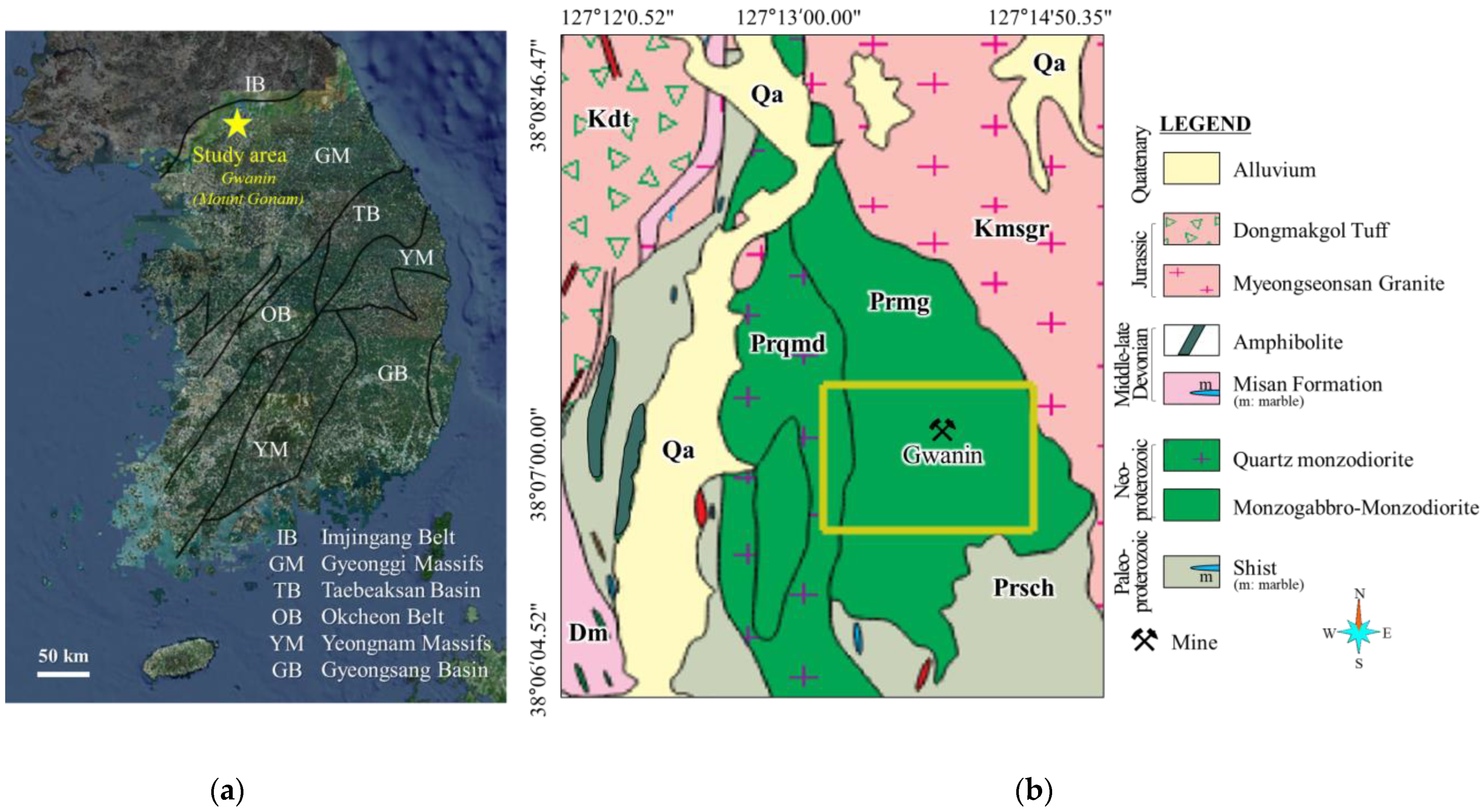
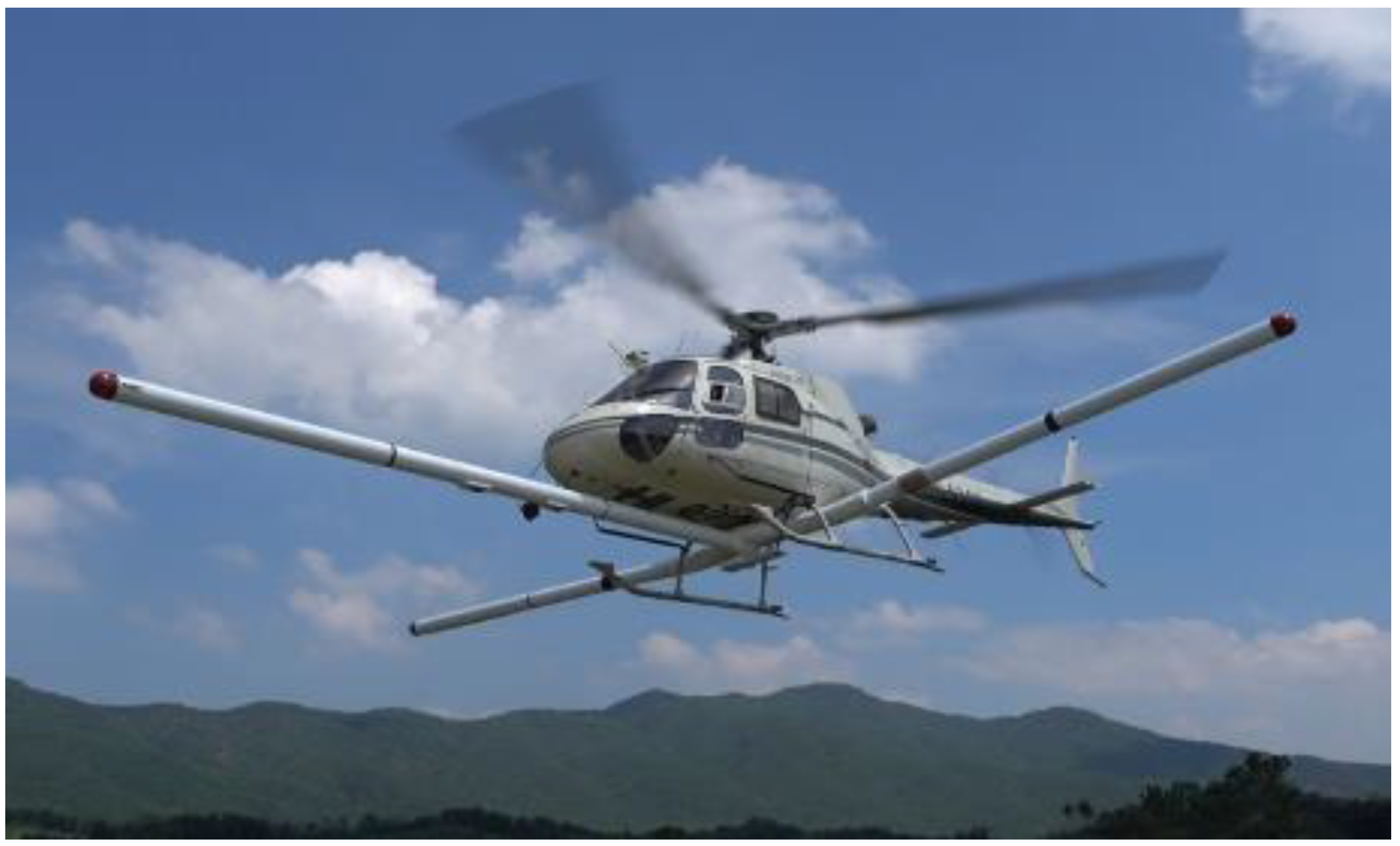
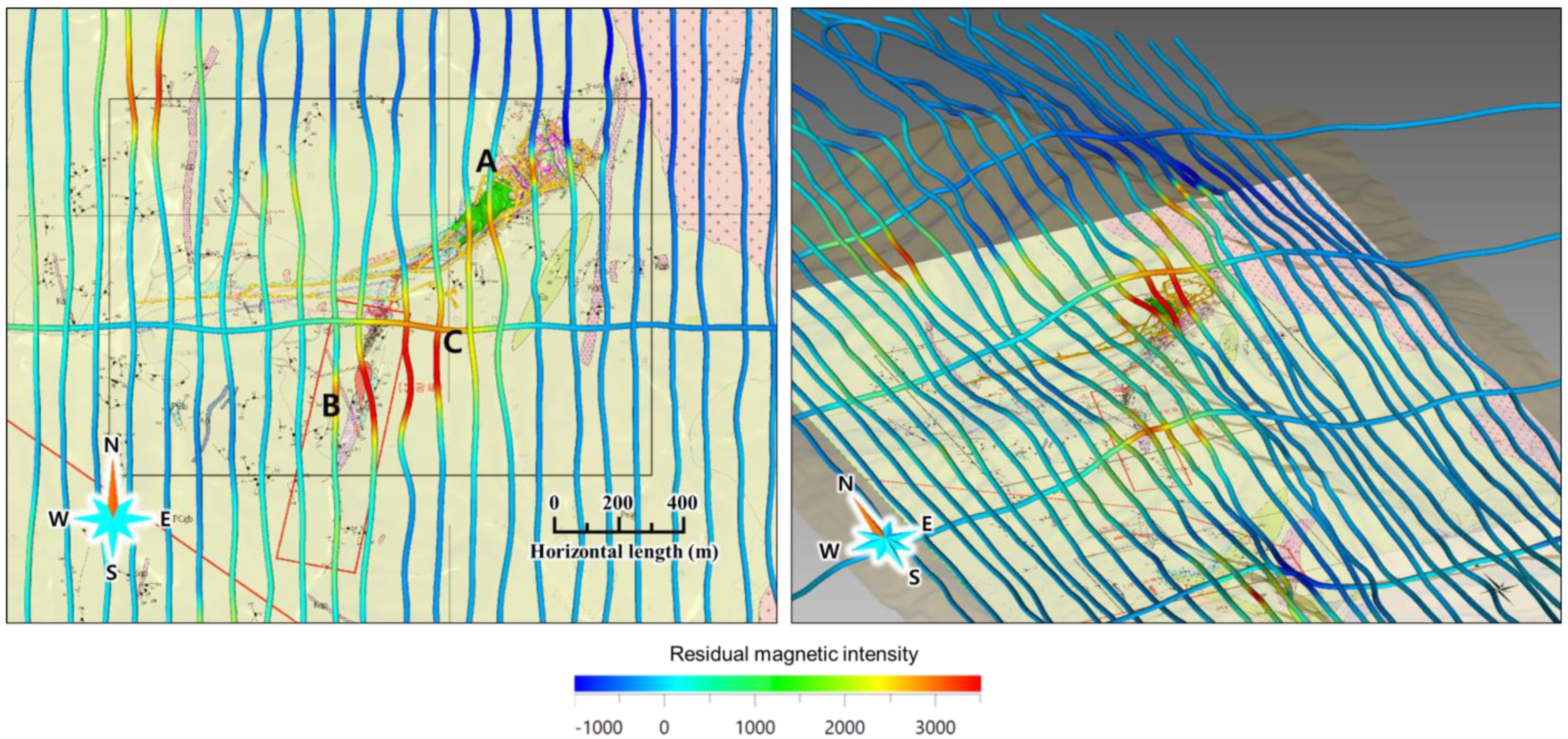
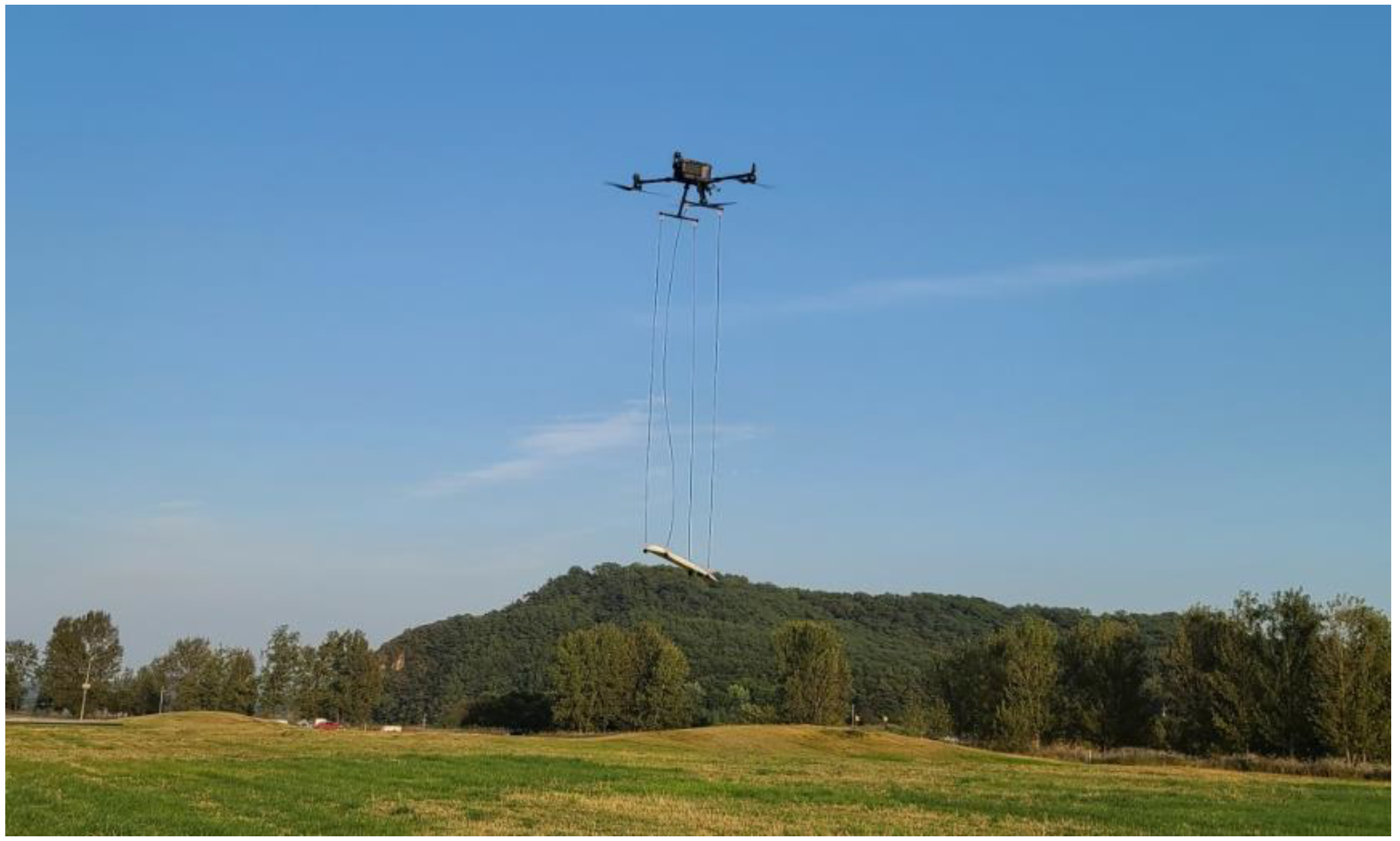
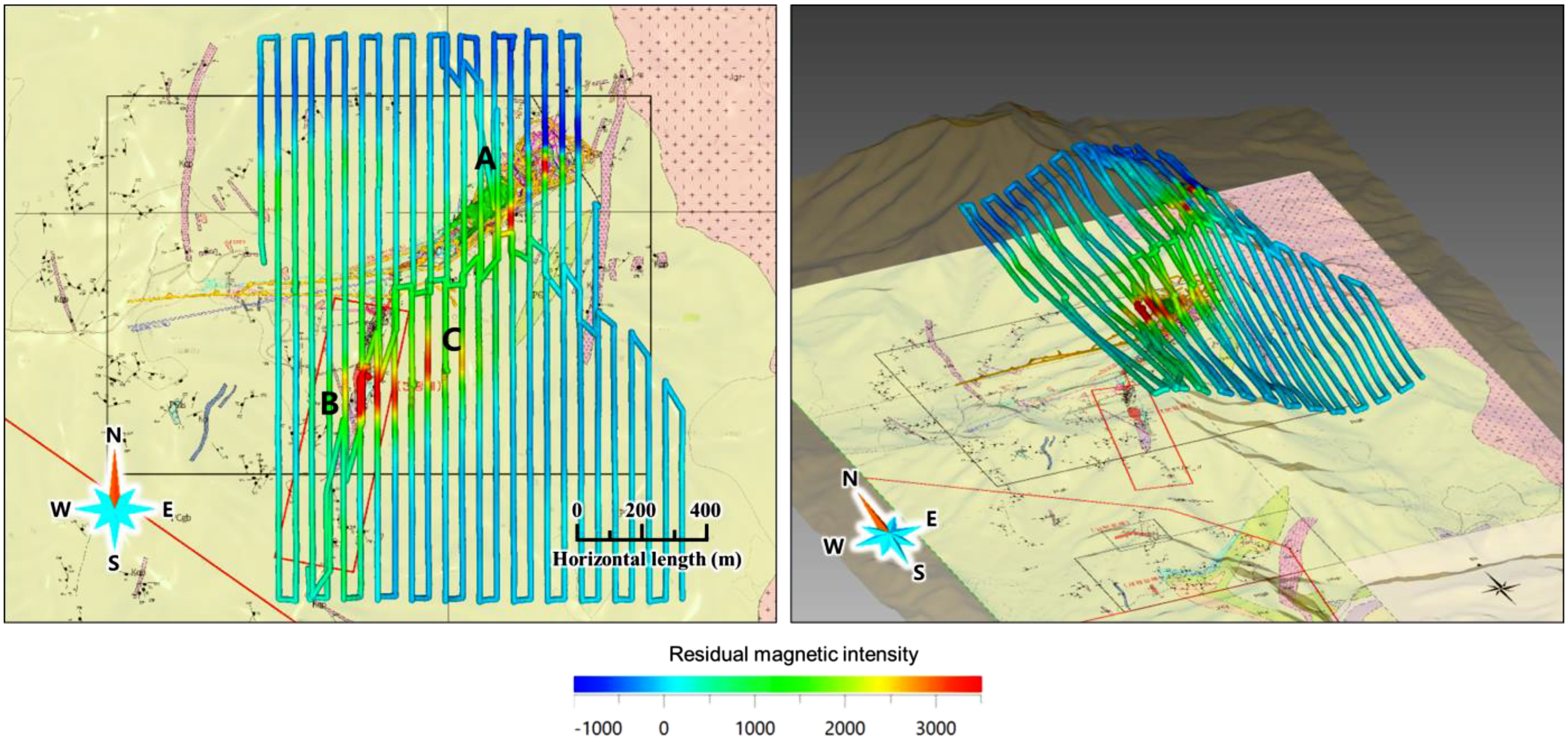
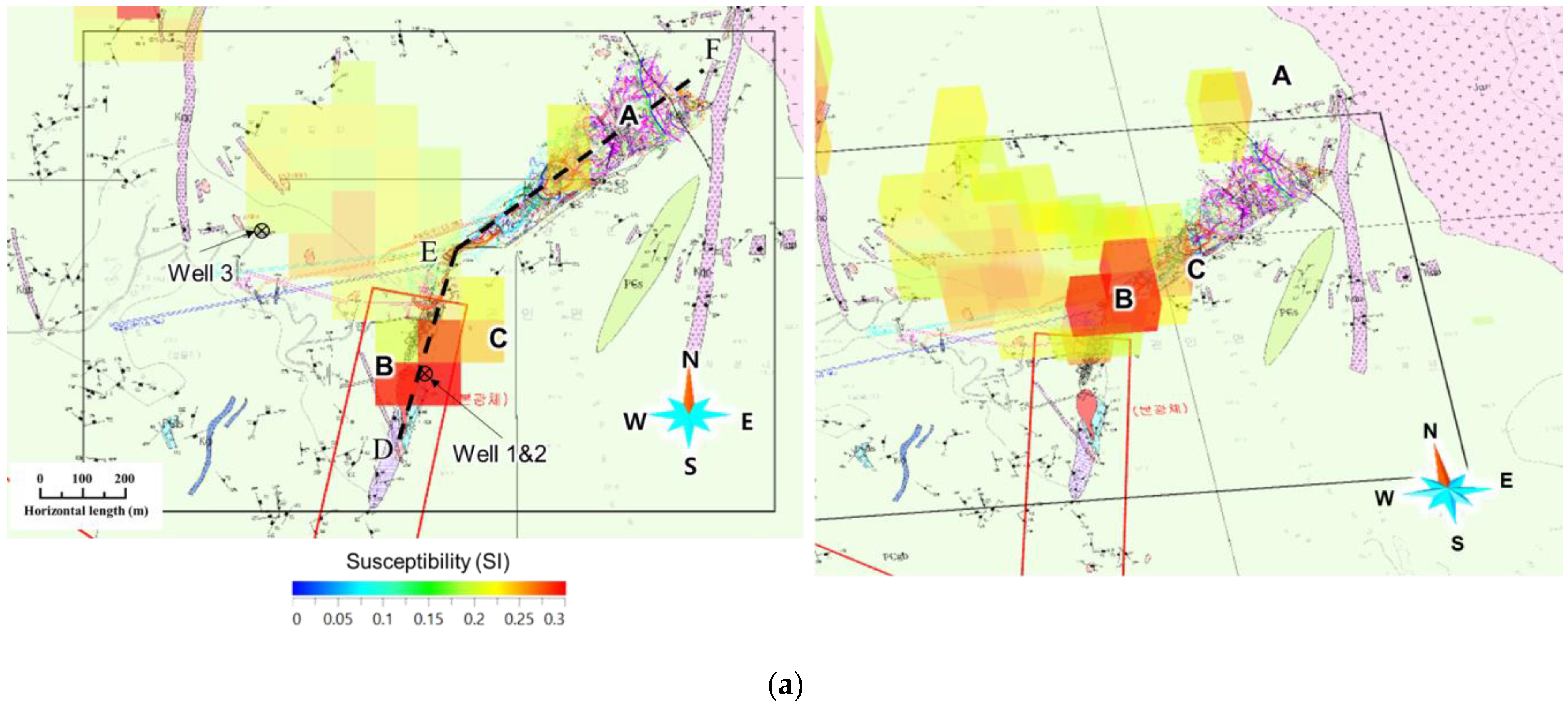


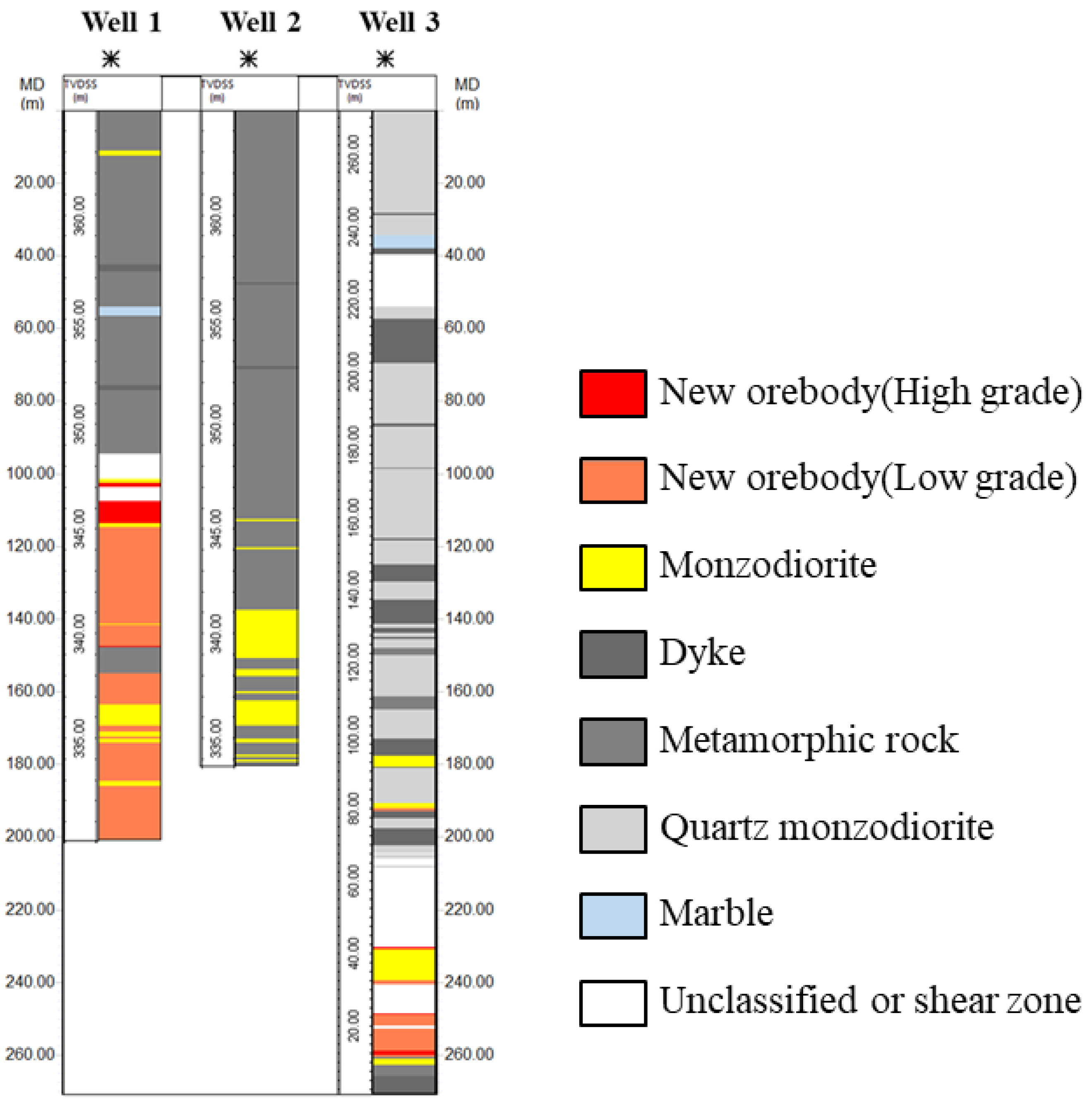
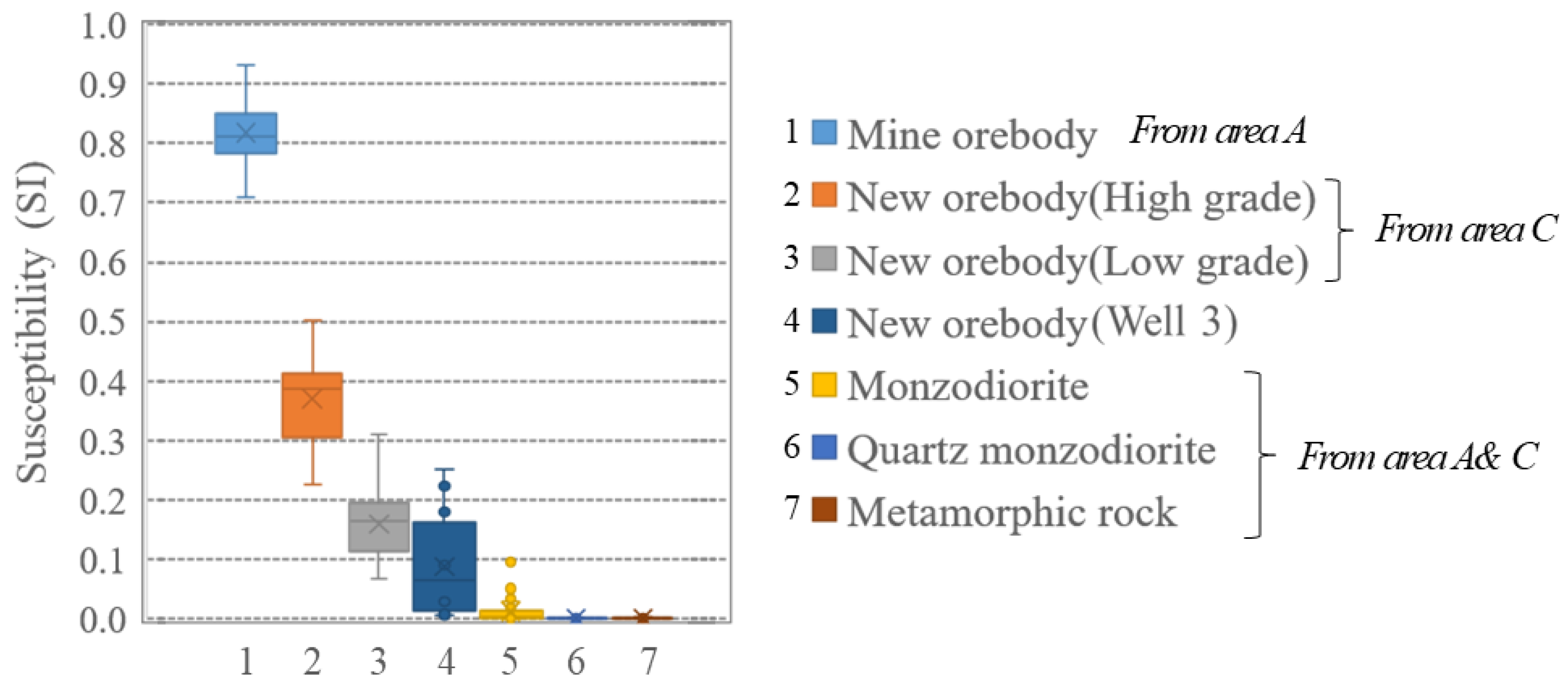
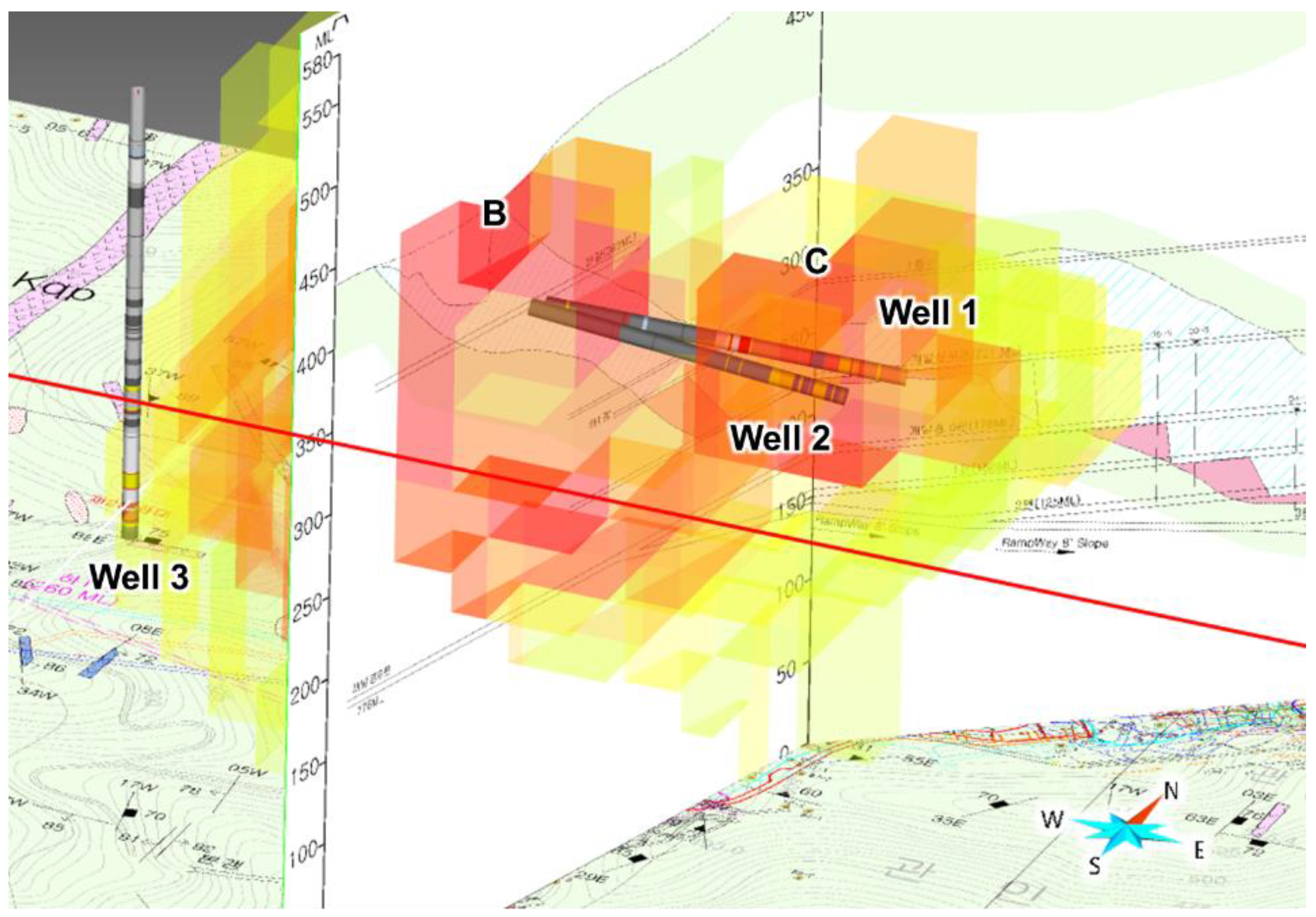
Publisher’s Note: MDPI stays neutral with regard to jurisdictional claims in published maps and institutional affiliations. |
© 2021 by the authors. Licensee MDPI, Basel, Switzerland. This article is an open access article distributed under the terms and conditions of the Creative Commons Attribution (CC BY) license (https://creativecommons.org/licenses/by/4.0/).
Share and Cite
Kim, B.; Jeong, S.; Bang, E.; Shin, S.; Cho, S. Investigation of Iron Ore Mineral Distribution Using Aero-Magnetic Exploration Techniques: Case Study at Pocheon, Korea. Minerals 2021, 11, 665. https://doi.org/10.3390/min11070665
Kim B, Jeong S, Bang E, Shin S, Cho S. Investigation of Iron Ore Mineral Distribution Using Aero-Magnetic Exploration Techniques: Case Study at Pocheon, Korea. Minerals. 2021; 11(7):665. https://doi.org/10.3390/min11070665
Chicago/Turabian StyleKim, Bona, Soocheol Jeong, Eunseok Bang, Seungwook Shin, and Seongjun Cho. 2021. "Investigation of Iron Ore Mineral Distribution Using Aero-Magnetic Exploration Techniques: Case Study at Pocheon, Korea" Minerals 11, no. 7: 665. https://doi.org/10.3390/min11070665
APA StyleKim, B., Jeong, S., Bang, E., Shin, S., & Cho, S. (2021). Investigation of Iron Ore Mineral Distribution Using Aero-Magnetic Exploration Techniques: Case Study at Pocheon, Korea. Minerals, 11(7), 665. https://doi.org/10.3390/min11070665





